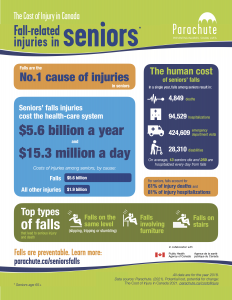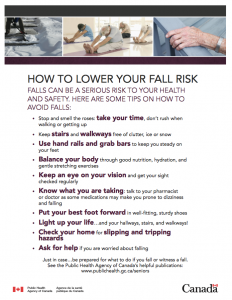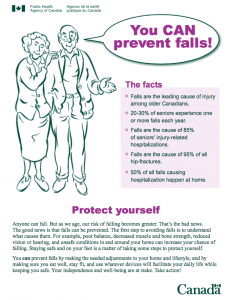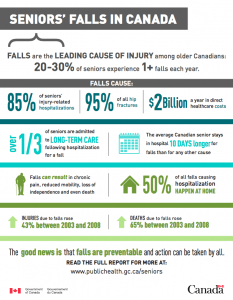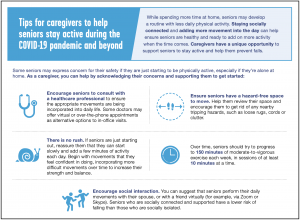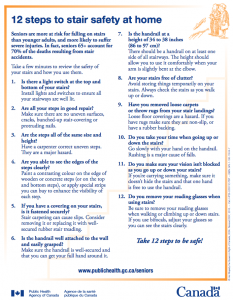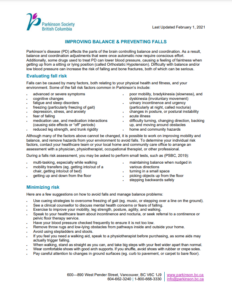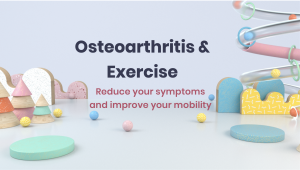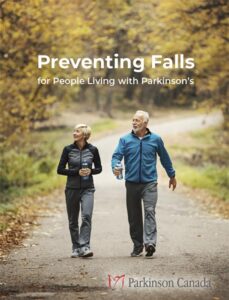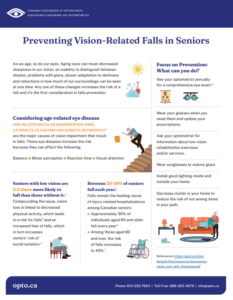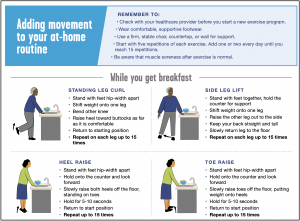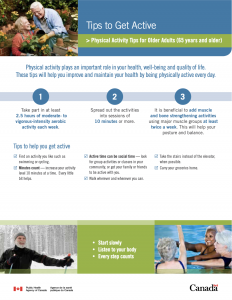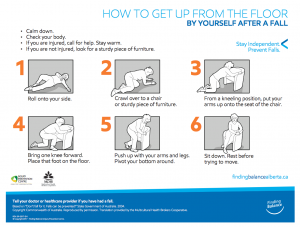Falls are the No. 1 reason for injury-related death, hospitalization and emergency department visits for older adults in Canada. Falls among older adults cost $5.6 billion in 2018 – nearly 20 per cent of the total cost of injury in Canada.
Our bodies naturally change with age and these changes affect the way we feel, move, and behave. A fall can have a devastating and lasting impact on a person, resulting in injury, chronic pain and a reduced quality of life. Even without an injury, a fall can cause an older adult to lose confidence and reduce their activities. The good news is that there are actions you can take to prevent falls.
Check out our resources section below to find information on how to assess risk, how to prevent a fall, how to get up safely after a fall, falls and their connection to various issues such as vision, medication, chronic diseases, cognitive impairment and more.
Key strategies to prevent falls
These are the most effective steps you can take to prevent a fall, as assessed by the Public Health Agency of Canada and Finding Balance, a program for older adults and caregivers created by the Injury Prevention Centre at the University of Alberta.
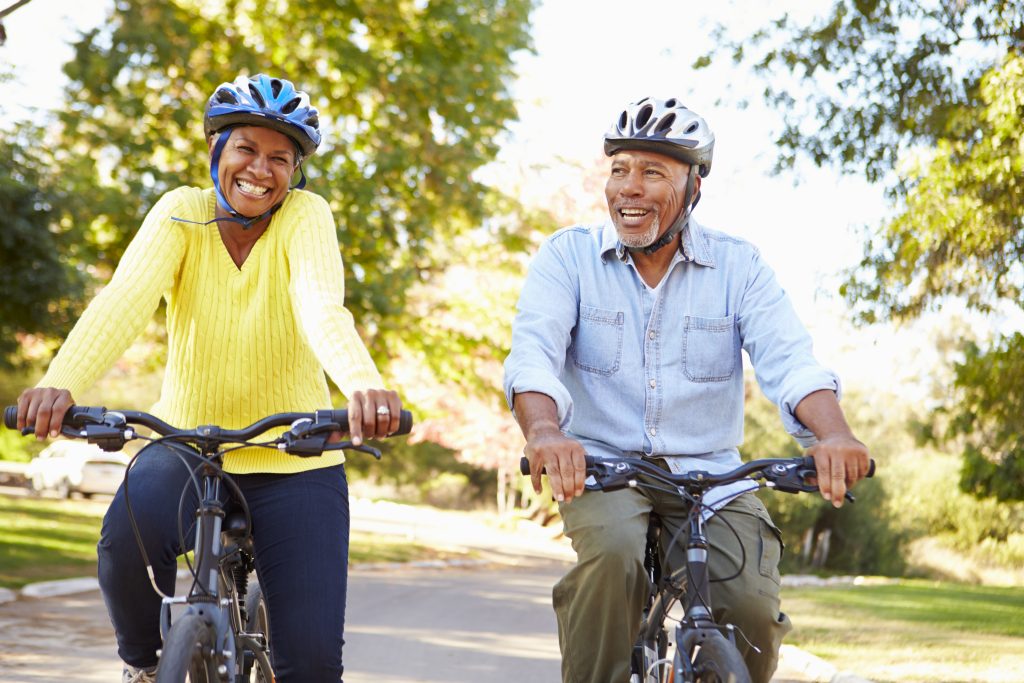
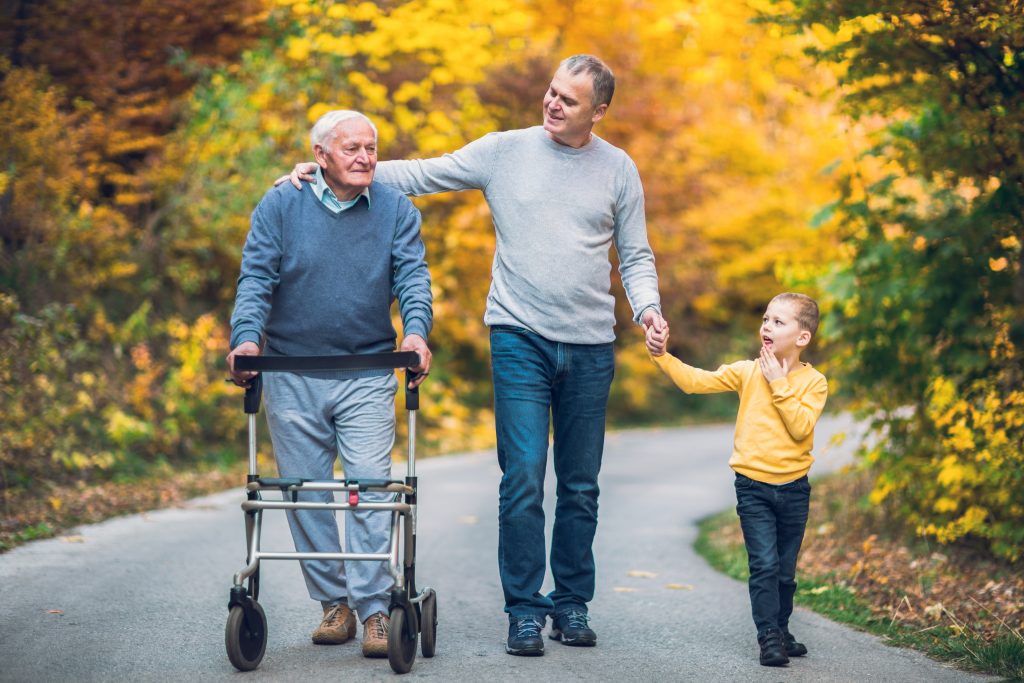
- Exercise: challenge your balance and build strength.
- Get enough sleep.
- Take your time: don’t rush when walking or getting up.
- Balance your body through good nutrition and hydration.
- Get your sight and hearing checked regularly.
- Manage your medications and review them regularly with your pharmacist or doctor as some may make you prone to dizziness and falling.
- Wear well-fitting, sturdy shoes.
- Consider using a cane or other mobility device if needed.
- Maintain proper use of eyeglasses and hearing aids.
In your home
- Make sure you have proper lighting in hallways, stairs and walkways, as well as in the bedroom and bathroom.
- Keep stairs free of clutter and exterior stairs and walkways free of clutter, ice or snow.
- Install hand rails along stairs and safety grab bars in the bathroom.
- Check your home for slipping and tripping hazards, and use non-slip mats or rugs.
- Ensure regularly used items are within reach.
Canada’s aging population
The proportion of Canadians aged 65 or older is projected to increase from 17.5% in 2019 to between 21.4% and 29.5% by 2068.
Source: Statistics Canada
Fall prevention is critical as our Canadian population ages; without successful prevention strategies, we face a difficult and pressing issue of providing treatment and facilities to care for those who have been injured due to a fall.
Resources
Cost of falls
-
Cost of injury – Falls in seniors infographic
#FallPreventionCanada Campaign
Parachute partnered with Brittlestar, “The Internet’s Favourite Dad”, to produce a series of short videos featuring Brittlestar and his real-life mom having humorous conversations to convince her to exercise and take other actions that will prevent falls. The videos tell people how to find Parachute’s fall-prevention resources developed as part of our #FallPreventionCanada campaign. This campaign won the Gold award for best short video at the 2022 International Safety Media Awards.
-
Brittlestar and his mom: Explaining fall prevention
-
Brittlestar and his mom: Fall prevention exercises are easy (for some people)
-
Brittlestar and his mom: Stand for clear floors (or you’ll fall for anything)
Fall prevention – general
The resources below will help you understand your fall risk and proven strategies to prevent falls.
-
Move, Improve, Remove Posters
These posters promote healthy aging and fall prevention. They are aimed at older adults and designed to be posted in a variety of settings (e.g., hospitals, clinic waiting rooms, pharmacies, community buildings, long-term care and retirement facilities etc.).
-
Am I at risk for a fall? – Finding Balance Alberta
Use this falls risk self-assessment quiz to find out if you are at risk for a fall.
-
Avoid falls with four simple tips – Mc
Master Optimal Aging This blog from McMaster Optimal Aging Portal describes four simple changes to your physical health that can help you stay steady on your feet.
-
Bruno and Alice: A Love Story in Twelve Parts About Seniors and Safety
This series of twelve illustrated stories follows the whimsical romance of two active seniors who, through lack of prevention, end up in awkward situations and almost miss their rendezvous with love. The stories offer insight into some of the personal preventive measures seniors can take to make their environment safer and prevent injuries.
-
Falls Prevention – Vancouver Coastal Health
Resources – including a brochure, a home activity program and services – available to help you understand and avoid falls.
-
Falls: Common, Costly and Preventable (webinar)
Recorded Thursday Nov. 18, 2022, and organized by the Canadian Association of Retired Persons (CARP) featuring Nancy Edwards, Professor Emeritus and Distinguished Professor at the University of Ottawa; Dori Krahn, Community Relations Co-ordinator for the Saskatoon Fire Department who leads the Remembering When program, a fire safety and fall prevention program for older adults; and Stephanie Cowle, Director of Knowledge Translation at Parachute.
-
How to lower your fall risk – Public Health Agency of Canada
-
How can I prevent a fall? – Finding Balance Alberta
Discover valuable information and practical strategies to help prevent falls with Finding Balance Alberta’s comprehensive resource.
-
Preventing Falls in Older Adults (Saskatchewan Health Authority)
The Saskatchewan Health Authority Preventing Falls in Older Adults webpage has useful information for preventing falls in older adults.
-
You CAN prevent falls – Public Health Agency of Canada
-
Seniors’ Falls in Canada
-
Staying Independent Checklist
The Staying Independent Checklist is a tool that can be used by older adults, health care providers or caregivers to assess an adult’s risk for falls. This tool is for older adults living in their own home, as it is not validated for institutional living adults. Users answer “Yes”/”No” to a list of statements and are given a score based on their response. The total score is tallied up and a recommendation is provided depending on how high the individual scores.
Footwear
-
Better Winter Footwear Handout
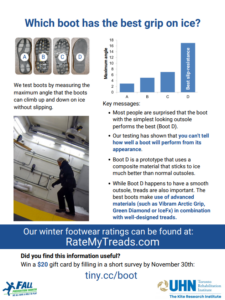
A new generation of winter footwear can significantly reduce the risk of slipping and falling on icy surfaces. This infographic produced by the KITE Research Institute at University Health Network highlights the importance of using KITE’s lab-based testing to determine footwear effectiveness on ice because looks can be deceiving.
-
CARP Ottawa: Winter footwear and staying active in winter
Session 1 of 3 from the C.A.R.P. Ottawa Chapter’s fall prevention webinar series in November 2020.
Leigh Vanderloo (Knowledge Translation Manager, ParticipACTION) describes the importance of maintaining physical activity during winter months and movement guidelines.
Tilak Dutta (Scientist, KITE Research Institute, University Health Network) describes how his lab tests gripability of winter boots and how they rate winter boots that provide better friction on ice.
Judy Andrew-Piel (Community Support Coordinator, Bushtukah) explains traction basics with practical tips regarding safer outdoor winter footwear.
-
Rate my Treads
Rate my Treads is a website that provides ratings for various types of winter footwear for their slip resistance in different winter conditions.
Rate my Treads is a product of iDAPT, the research arm of the Toronto Rehabilitation Institute – University Health Network located in Toronto. iDAPT works with a broad range of clinicians, engineers, scientists, researchers, students and more to find practical solutions to common problems.
For caregivers
-
Carers Canada
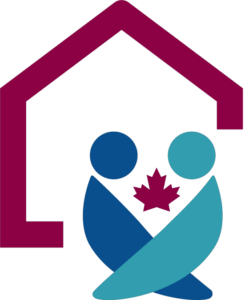
Carers Canada is a priority initiative of the Canadian Home Care Association, a national non-profit membership group dedicated to advancing excellence in home and community care so Canadians can choose to live safely and independently in their communities. Through federal advocacy and national awareness campaigns, the goal of Carers Canada is to increase recognition and support for caregivers. Carers Canada’s vision is to “create a Canada that recognizes, respects and values the integral role of carers in society.” A founding member of the International Alliance of Carer Organizations, Carers Canada is part of a global initiative championing caregivers’ rights.
-
Ontario Caregiver Organization
The Ontario Caregiver Organization (OCO) exists to support Ontario’s 3.3 million caregivers; ordinary people who provide physical and emotional support to a family member, partner, friend or neighbour. It supports caregivers by being their one point of access to information, so they have what they need to be successful in their role.
-
Tips for caregivers to help seniors stay active during the COVID-19 pandemic and beyond
Home modifications and safety
The guides below will help you ensure your home is as safe as possible and free from fall hazards.
-
CARP Ottawa: How to make stairs safer for everyone
Session 3 of 3 from the C.A.R.P. Ottawa Chapter’s fall prevention webinar series in November 2020.
Sarah Fraser (Assistant Professor, Faculty of Health Sciences, University of Ottawa) describes assessing stairs for safety and showed common examples of fall hazards on stairs.
Craig White (Branch Manager, Stannah Stair Lifts) describes what to consider when deciding whether or not to install a stair lift as an option to more safely navigate stairs.
-
CARP Ottawa: Make your bathroom safer
Session 2 of 3 from the C.A.R.P. Ottawa Chapter’s fall prevention webinar series in November 2020.
Paulette Guitard (Professor and Occupational Therapist, School of Rehabilitation Scientist, University of Ottawa) describes how and why grab bars that are properly installed in bathrooms can prevent falls.
Peter Hache (Owner of Renos4Life – formerly Renos4Seniors) describes considerations and innovations in the design and renovation of bathrooms that are safer.
-
Maintaining Senior’s Independence Through Home Adaptations
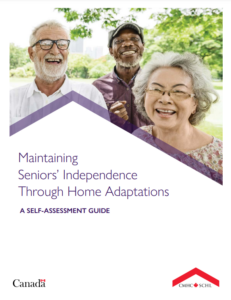
This self-assessment guide was developed by the Canada Mortgage and Housing Corporation. Designed for older adults, this large-print guide identifies the types of difficulties older adults can experience in the home and describes adaptations to overcome these difficulties. This Guide helps older adults assess their own unique circumstances including using stairs, moving around the house, doing laundry and answering the door. The Self-Assessment Guide would be of interest not only to older adults but their families and caregivers. (March 31, 2018).
-
Preventing Falls on Stairs
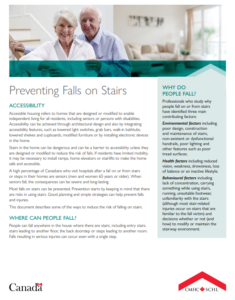
This fact sheet describes the common causes of falls on stairs and provides many strategies to help prevent them. Most falls can be prevented through good planning and recognition of the health, environmental and behavioural contributors to falls. Includes design suggestions for safe stairs and a glossary of terms. (© 2004 CMHC, Revised 2016)
-
Room-by-room guide to eliminate causes of falls – Philips Lifeline
Use this resource to eliminate common fall risks in each room of your home.
-
Safer Bathrooms, Safer Bathing
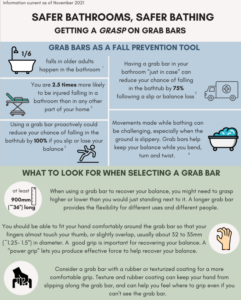
Navigating a slippery bathtub or shower can be challenging, but grab bars can help you move safely and confidently in your bathroom. In this infographic from the KITE Research Institute at University Health Network, find out what features to look for in a grab bar, and where to install it. Check out the links at the bottom of the infographic for resources, and where to turn if you need more help.
1,000.93 KB PDF
-
The Safe Living Guide – A Guide to Home Safety for Seniors
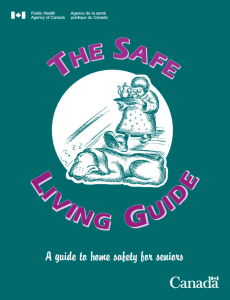
Through this guide, the Public Health Agency of Canada provides advice on how to prevent injuries by keeping your home, yourself and your environment as safe as you can. Checklists allow you to verify and increase the safety of your surroundings and lifestyle, and real-life stories offer testimony to the value of adapting.
-
12 Steps to stair safety at home – Public Health Agency of Canada
Individual factors
-
Balance exercises for people living with Parkinson’s disease – Video Series
This video series includes several low-impact balance exercise classes with Parkinson Society BC’s neuro physiotherapist, Shelly Yu. These classes focus on lower extremity strength and agility-type activities required for fall prevention, such as multidirectional stepping, weight shifting, and turning.
-
Balance exercises for people living with Parkinson’s disease – Tip Sheet
-
Body
Break and Avoiding Frailty BodyBreak is a program that encourages Canadians to live healthy, active lifestyles. The BodyBreak program provides videos showcasing how practical and easy it is to do.
-
Body
Break and Avoiding Frailty – Videos BodyBreak’s YouTube Channel consists of five videos on the topic of avoiding frailty.
-
Canadian Frailty Network
Canadian Frailty Network (CFN) is Canada’s sole network devoted to improving care for older Canadians living with frailty and supporting their families and caregivers.
-
Find an occupational therapist – Canadian Association of Occupational Therapists
A platform to help Canadians access the occupational therapy services they need.
-
Osteoarthritis and Exercise – Health
HQ -
People living with arthritis
Arthritis Research Canada has developed two videos on fall prevention for those living with arthritis.
Episode 7 of the Arthritis Research Education Series focuses on how this organization is working to prevent falls in older adults through research and why this topic is important for people living with arthritis.
Learn how to prevent falls from Senior Scientist and physiotherapist, Dr. Linda Li, in Preventing Falls in Older Adults webinar recording.
-
Physical activity for people living with osteoporosis
Osteoporosis Canada has developed a video series on exercise and osteoporosis in partnership with the University of Waterloo and Geriatric Education and Research in Aging Sciences Centre which provides ideas for safe and effective exercise and physical activity.
The video series tells the stories of four very different people with osteoporosis and showing their innovative solutions to keep healthy and active.
-
Preventing Falls: A Guide for People Living With Parkinson’s
-
Preventing vision-related falls in seniors
-
Vision
This webpage from the Government of British Columbia offers questions to ask yourself and suggested actions to take to assess and reduce your risk of vision-related falling risks.
Medication management
-
Canadian Medication Appropriateness and Deprescribing Network – Medications and Falls
The Canadian Medication Appropriateness and Deprescribing Network has a webpage with information on medications that are more likely to cause you to fall. Learn about the different types of medications and which ones may increase your risk of falling. Always consult your doctor about your risk for falling when you are being prescribed new medication, or if you think your current medication will increase your risk for falling.
Organizations
-
Finding Balance Alberta
Finding Balance is a falls prevention program that provides seniors and practitioners with the latest information and resources to help seniors live an active and independent lifestyle. The program uses real life strategies that older adults can use to lower their risk of a fall.
-
Finding Balance BC
The Finding Balance campaign raises awareness about preventing falls among older Canadians. It provides valuable resources for both older adults and practitioners.
-
Finding Balance New Brunswick
The Finding Balance campaign raises awareness about preventing slips, trips, and falls among older Canadians. It offers resources for older adults and practitioners to promote safety and well-being.
-
Finding Balance Newfoundland and Labrador: Western Health Region
Finding Balance Newfoundland has two websites for two of their health regions. This website is for their Western Health Region. Both websites provide information on the Finding Balance Campaign with posters available. Other resources link to Fall Prevention Month.
Staying active and healthy eating
The resources below provide helpful information on how to safely add more movement into your daily life, whether inside or outside of the home.
-
Healthy Living Workshop (Active Aging Canada)
Active Aging Canada’s Healthy Living Workshop resources include:
Your Personal Passport to Healthy Living
Tool Kit for Healthy Living Workshops for Older Adults
Guidebook for Community Leaders
Virtual Facilitation Training Slide Deck (English only)
24-Hour Movement Guidelines and Workshop Posters
-
Adding movement to your at-home routine
-
Canada’s Food Guide – Healthy Eating for Seniors
Learn why healthy eating is important for older adults. The Government of Canada’s website provides information on healthy eating specifically for older adults, further reading and healthy recipes.
-
Canadian Malnutrition Task Force
The Canadian Malnutrition Task Force (CMTF) aims to reduce malnutrition by promoting nutrition care knowledge and optimal practice through research and education activities focused on preventing, detecting and treating malnutrition in Canadians. CMTF’s mandate also includes informing stakeholders and the public about the importance of optimal clinical nutrition care in hospital settings. One hidden impact of poor nutrition is an increased risk of falls.
-
COVID-19 and Nutrition
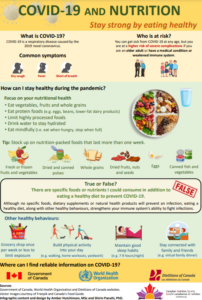
This infographic provides guidance on how to stay strong and healthy through good nutrition during the pandemic. Healthy eating can help prevent muscle and bone loss to reduce risk of falling or breaking bones. It provides basic information on symptoms of COVID-19, at-risk population, good nutrition guidance and other healthy behaviour.
970.17 KB PDF
-
Home Activity Program – Vancouver Coastal Health
Designed for home and community care clients to improve balance and muscle strength. To assist people with different abilities, the program has three levels of activities. These include activities that may be done while sitting, standing or moving. All levels promote health, well-being and prevent falls.
-
Movement Snacks
To support older adults in moving more at home, Later Life Training in the United Kingdom developed movement snacks. These 20-minute videos posted on Facebook and YouTube encourage everyone to move more throughout the day, especially if you’re not able to get outside. There are more than 500 videos now on You Tube and it’s recommended you start at the beginning of the series.
-
Physical activity for older adults
A new resource from Active Aging Canada that informs older Canadians on how to engage in safe, successful physical activity. It was developed by their partners: the Canadian Society for Exercise Physiology and Exercise is Medicine® Canada.
-
Physical Activity Toolkit for Older Adults– Particip
ACTION 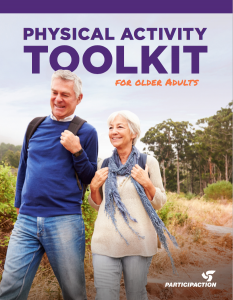
To help older adults sit less and move more, ParticipACTION developed a Physical Activity Toolkit for Older Adults! The toolkit includes physical activity guidelines, a walking program, a movement log, articles on the role physical activity plays in prevention and management of chronic disease, plus lots of useful resources to help older adults get moving.
-
Physical Activity Tips for Older Adults (65 years and older) – Government of Canada
-
Too Fit to Fracture
Too Fit To Fracture are evidence-based recommendations to help reduce the risk of fractures.
28.93 MB Link
What to do after a fall
These resources let you know what to do if you or a loved one suffers a fall.
-
How to safely help someone to get up – Poster
Guiding someone to get up after they’ve had a fall prevents you and them from being injured.
Below is a poster on how to safely help someone to get up.
-
How to safely help someone to get up – Video
Below is a video that provides instructions on what to do if someone falls.
-
If I fall, what do I do? – Finding Balance Alberta
-
If you fall or witness a fall, do you know what to do? – Public Health Agency of Canada
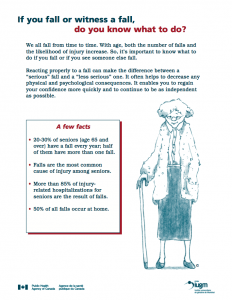
Discover essential knowledge and practical steps to prevent falls and respond effectively with the Fall Prevention and Response resource provided by the Public Health Agency of Canada. From prevention strategies to immediate response guidelines, empower yourself to promote safety and well-being in your community.
-
Virtual Care Guide for Patients
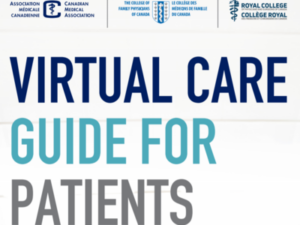
In collaboration with patients and their families, the Canadian Medical Association, the College of Family Physicians of Canada and the Royal College of Physicians and Surgeons of Canada have created this guide to help patients prepare for “virtual visits” with their doctor. It focuses on video visits, although it is also possible to receive virtual care through phone calls, text messaging and email. We recommend that you read the entire guide to gain the best possible results.
Injury Topics
Media
-
Link
Parachute Canada highlights awareness of preventable falls in honour of Fall Prevention Month
Thompson Today — October 22, 2024
-
Link
Locally made fall prevention video series wins international award
Beacon Herald — October 10, 2024
-
Link
Sophia Loren was hospitalized after a fall. Why is falling so dangerous for seniors?
Yahoo News — September 25, 2023
-
Link
Why are these scientists teaching seniors how to fall
Toronto Star — March 24, 2023
-
Link
How You Can Reduce the Risk of Falls as an Older Adult
www.healthinsight.ca — June 13, 2022
-
Link
Take action to prevent falls – Active aging Canada
www.activeagingcanada.ca — November 10, 2021
-
Link
Staying safe in your castle
Sagelink.ca — February 15, 2021
-
Link
Falls are the leading cause of hospital visits involving seniors
CTV News — July 11, 2019
-
Link
Public Health Agency of Canada supports fall prevention among Canadian seniors
Public Health Agency of Canada — February 12, 2019
